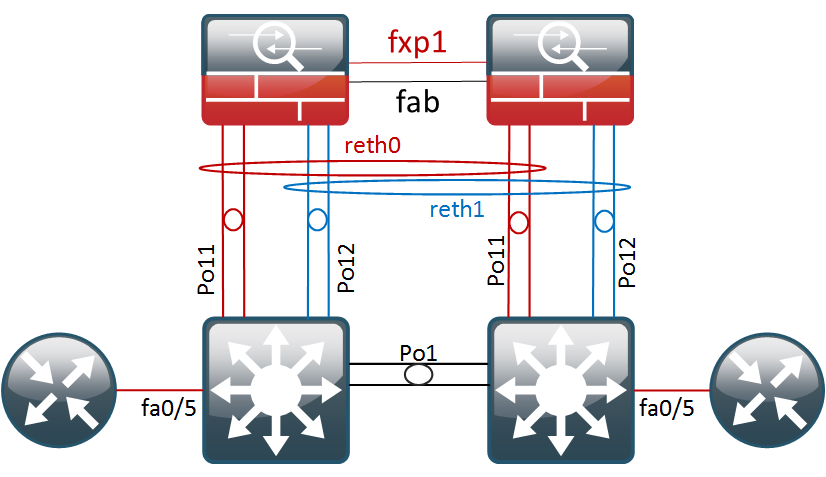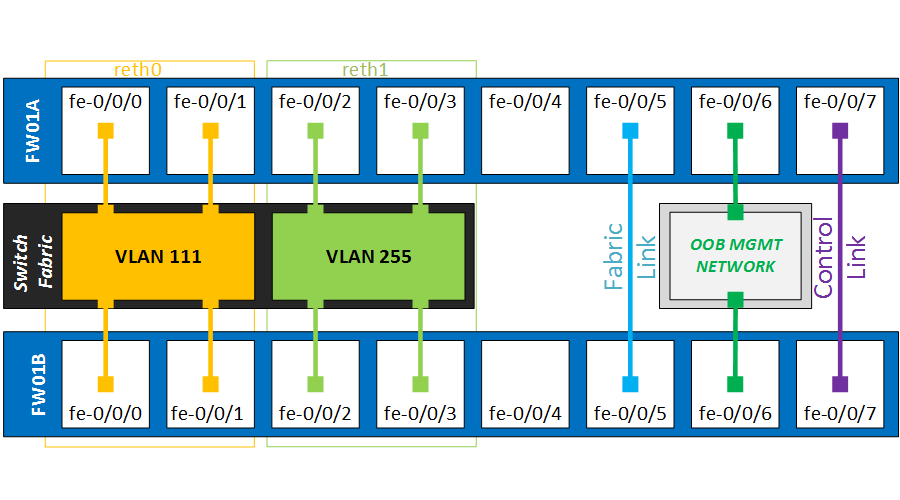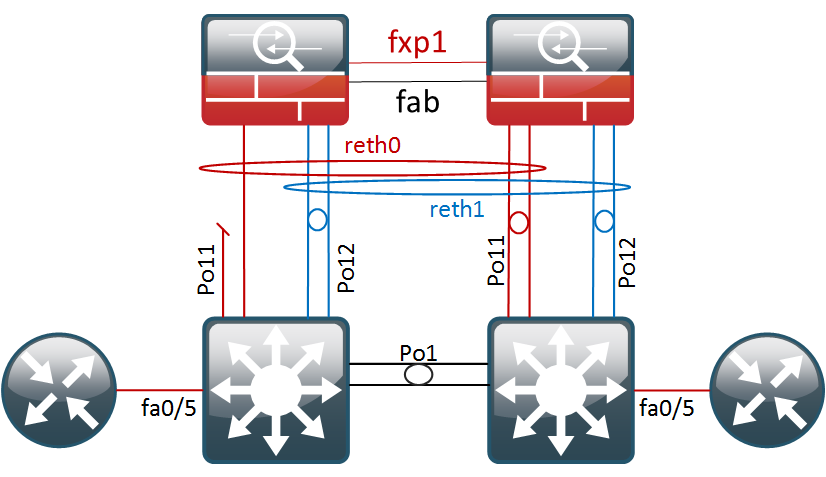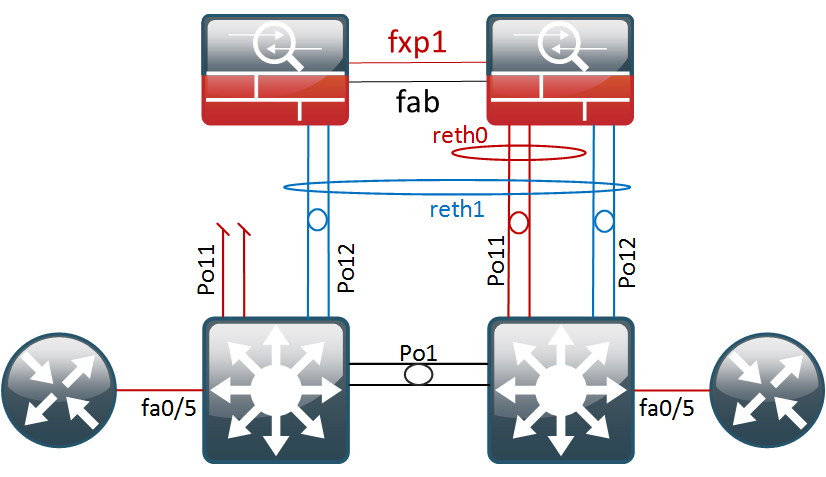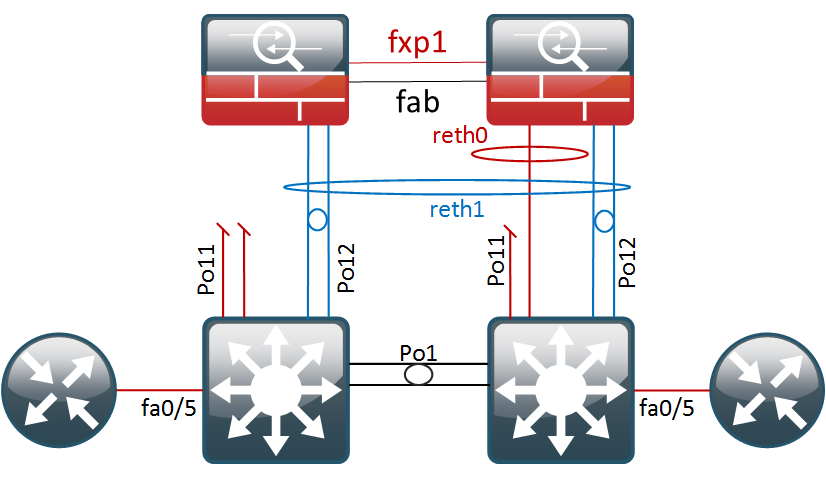The Juniper Virtual Chassis technology allows you to combine multiple physical switches into one logical switch stack, which reduces the management overhead of dealing with many switches. Because all members are acting as a single device, with a proprietary control protocol underneath, there is no need for Spanning Tree and its blocked links. It also has dual routing engine support, albeit with some feature limitations on the EX2200 platform.
Unlike the high-end Juniper switches, the EX2200 does not have dedicated virtual-chassis ports either, so you are limited to using the on-board ethernet ports. The cross-member bandwidth should be OK for basic access deployments though, so here’s how to set it up.
First, gather the serial numbers of all your switches. There are several commands that will show you the serial. I’ve used show chassis hardware
root> show chassis hardware Hardware inventory: Item Version Part number Serial number Description Chassis CW0210160462 EX2200-24T-4G Routing Engine 0 REV 11 750-026468 CW0210160462 EX2200-24T-4G FPC 0 REV 11 750-026468 CW0210160462 EX2200-24T-4G CPU BUILTIN BUILTIN FPC CPU PIC 0 BUILTIN BUILTIN 24x 10/100/1000 Base-T PIC 1 REV 11 750-026468 CW0210160462 4x GE SFP Power Supply 0 PS 100W AC Fan Tray Fan Tray
Do this for all your switches and copy them to notepad. You will need them later. Mine are indicated on the diagram below.
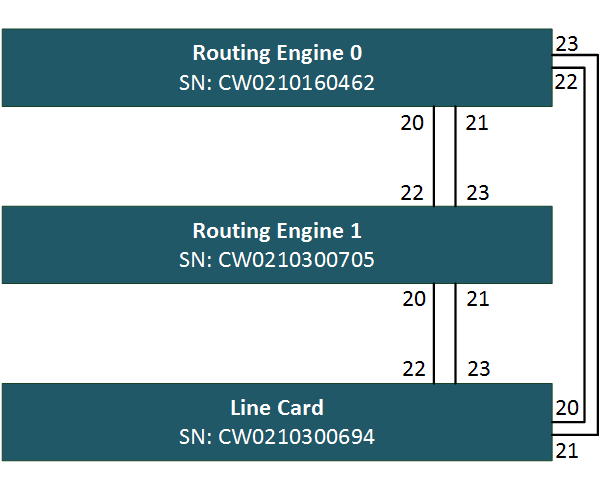
Next, we need to configure our Ethernet ports for virtual-chassis functionality. The EX2200 does not have dedicated VCP ports so we need to convert some ethernet ports. As shown on the drawing, I will use the last four ports on each switch. To activate the ports for VC functionality, enter the following commands.
{master:0}
root> request virtual-chassis vc-port set pic-slot 0 port 20
{master:0}
root> request virtual-chassis vc-port set pic-slot 0 port 21
{master:0}
root> request virtual-chassis vc-port set pic-slot 0 port 22
{master:0}
root> request virtual-chassis vc-port set pic-slot 0 port 23
Rinse and repeat on switch two and three. You can verify the ports were added correctly to the virtual chassis with the following command.
root> show virtual-chassis vc-port fpc0: -------------------------------------------------------------------------- Interface Type Trunk Status Speed Neighbor or ID (mbps) ID Interface PIC / Port 0/20 Configured -1 Down 1000 0/21 Configured -1 Down 1000 0/22 Configured -1 Down 1000 0/23 Configured -1 Down 1000
Before we can move on to connecting the cables, we have to set up the virtual chassis parameters on our primary routing engine.
We will set up the virtual-chassis in pre-provisioned mode, where we manually tie the serial ids to the member id. The first two switches will be configured as routing engines, one master and one backup, and the last switch will serve as a dumb old line-card. In my case, the virtual chassis configuration on routing engine 0 looks like this:
{master:0}[edit virtual-chassis]
root# show
preprovisioned;
member 0 {
role routing-engine;
serial-number CW0210160462;
}
member 1 {
role routing-engine;
serial-number CW0210300705;
}
member 2 {
role line-card;
serial-number CW0210300694;
}
Now that this is set up, I have connected the cables and the virtual chassis has formed. You can verify VC state and inter-switch connectivity using the show virtual-chassis status command.
root> show virtual-chassis status
Preprovisioned Virtual Chassis
Virtual Chassis ID: fd81.5b7b.172c
Virtual Chassis Mode: Enabled
Mstr Mixed Neighbor List
Member ID Status Serial No Model prio Role Mode ID Interface
0 (FPC 0) Prsnt CW0210160462 ex2200-24t-4g 129 Master* NA 1 vcp-255/0/20
1 vcp-255/0/21
2 vcp-255/0/22
2 vcp-255/0/23
1 (FPC 1) Prsnt CW0210300705 ex2200-24t-4g 129 Backup NA 2 vcp-255/0/20
2 vcp-255/0/21
0 vcp-255/0/22
0 vcp-255/0/23
2 (FPC 2) Prsnt CW0210300694 ex2200-24t-4g 0 Linecard NA 0 vcp-255/0/20
0 vcp-255/0/21
1 vcp-255/0/22
1 vcp-255/0/23
This command shows us the IDs, serials and roles of all the members. The far-right columns also show on which ports the neighbours are detected. You can use this to verify everything is properly cabled up.
A quick terse command also shows us all interfaces in the stack are available, except for the ones we dedicated as VCP ports.
root> show interfaces terse | no-more
Interface Admin Link Proto Local Remote
vcp-255/0/20 up up
vcp-255/0/20.32768 up up
vcp-255/0/21 up up
vcp-255/0/21.32768 up up
vcp-255/0/22 up up
vcp-255/0/22.32768 up up
vcp-255/0/23 up up
vcp-255/0/23.32768 up up
ge-0/0/0 up down
ge-0/0/0.0 up down eth-switch
ge-0/0/1 up down
ge-0/0/1.0 up down eth-switch
ge-0/0/2 up down
ge-0/0/2.0 up down eth-switch
ge-0/0/3 up down
ge-0/0/3.0 up down eth-switch
ge-0/0/4 up down
ge-0/0/4.0 up down eth-switch
ge-0/0/5 up down
ge-0/0/5.0 up down eth-switch
ge-0/0/6 up down
ge-0/0/6.0 up down eth-switch
ge-0/0/7 up down
ge-0/0/7.0 up down eth-switch
ge-0/0/8 up down
ge-0/0/8.0 up down eth-switch
ge-0/0/9 up down
ge-0/0/9.0 up down eth-switch
ge-0/0/10 up down
ge-0/0/10.0 up down eth-switch
ge-0/0/11 up down
ge-0/0/11.0 up down eth-switch
ge-0/0/12 up down
ge-0/0/12.0 up down eth-switch
ge-0/0/13 up down
ge-0/0/13.0 up down eth-switch
ge-0/0/14 up down
ge-0/0/14.0 up down eth-switch
ge-0/0/15 up down
ge-0/0/15.0 up down eth-switch
ge-0/0/16 up down
ge-0/0/16.0 up down eth-switch
ge-0/0/17 up down
ge-0/0/17.0 up down eth-switch
ge-0/0/18 up down
ge-0/0/18.0 up down eth-switch
ge-0/0/19 up down
ge-0/0/19.0 up down eth-switch
ge-1/0/0 up down
ge-1/0/0.0 up down eth-switch
ge-1/0/1 up down
ge-1/0/1.0 up down eth-switch
ge-1/0/2 up down
ge-1/0/2.0 up down eth-switch
ge-1/0/3 up down
ge-1/0/3.0 up down eth-switch
ge-1/0/4 up down
ge-1/0/4.0 up down eth-switch
ge-1/0/5 up down
ge-1/0/5.0 up down eth-switch
ge-1/0/6 up down
ge-1/0/6.0 up down eth-switch
ge-1/0/7 up down
ge-1/0/7.0 up down eth-switch
ge-1/0/8 up down
ge-1/0/8.0 up down eth-switch
ge-1/0/9 up down
ge-1/0/9.0 up down eth-switch
ge-1/0/10 up down
ge-1/0/10.0 up down eth-switch
ge-1/0/11 up down
ge-1/0/11.0 up down eth-switch
ge-1/0/12 up down
ge-1/0/12.0 up down eth-switch
ge-1/0/13 up down
ge-1/0/13.0 up down eth-switch
ge-1/0/14 up down
ge-1/0/14.0 up down eth-switch
ge-1/0/15 up down
ge-1/0/15.0 up down eth-switch
ge-1/0/16 up down
ge-1/0/16.0 up down eth-switch
ge-1/0/17 up down
ge-1/0/17.0 up down eth-switch
ge-1/0/18 up down
ge-1/0/18.0 up down eth-switch
ge-1/0/19 up down
ge-1/0/19.0 up down eth-switch
ge-2/0/0 up down
ge-2/0/0.0 up down eth-switch
ge-2/0/1 up down
ge-2/0/1.0 up down eth-switch
ge-2/0/2 up down
ge-2/0/2.0 up down eth-switch
ge-2/0/3 up down
ge-2/0/3.0 up down eth-switch
ge-2/0/4 up down
ge-2/0/4.0 up down eth-switch
ge-2/0/5 up down
ge-2/0/5.0 up down eth-switch
ge-2/0/6 up down
ge-2/0/6.0 up down eth-switch
ge-2/0/7 up down
ge-2/0/7.0 up down eth-switch
ge-2/0/8 up up
ge-2/0/8.0 up up eth-switch
ge-2/0/9 up down
ge-2/0/9.0 up down eth-switch
ge-2/0/10 up down
ge-2/0/10.0 up down eth-switch
ge-2/0/11 up down
ge-2/0/11.0 up down eth-switch
ge-2/0/12 up down
ge-2/0/12.0 up down eth-switch
ge-2/0/13 up down
ge-2/0/13.0 up down eth-switch
ge-2/0/14 up down
ge-2/0/14.0 up down eth-switch
ge-2/0/15 up down
ge-2/0/15.0 up down eth-switch
ge-2/0/16 up down
ge-2/0/16.0 up down eth-switch
ge-2/0/17 up down
ge-2/0/17.0 up down eth-switch
ge-2/0/18 up down
ge-2/0/18.0 up down eth-switch
ge-2/0/19 up down
ge-2/0/19.0 up down eth-switch
bme0 up up
bme0.32768 up up inet 128.0.0.1/2
128.0.0.16/2
128.0.0.32/2
tnp 0x10
bme0.32770 down up eth-switch
bme0.32771 down up eth-switch
dsc up up
gre up up
ipip up up
lo0 up up
lo0.16384 up up inet 127.0.0.1 --> 0/0
lsi up up
me0 up down
me0.0 up down inet
mtun up up
pimd up up
pime up up
tap up up
vlan up up
vlan.0 up up inet 192.168.1.1/24
vme up down
We can login to other chassis member for troubleshooting by using the following command. When you log in to a line card JunOS will alert you that it shouldn’t be used for configuration.
root> request session member 2
--- JUNOS 12.3R11.2 built 2015-09-24 11:14:53 UTC
root@:LC:2%
root@:LC:2% cli
warning: This chassis is operating in a non-master role as part of a virtual-chassis (VC) system.
warning: Use of interactive commands should be limited to debugging and VC Port operations.
warning: Full CLI access is provided by the Virtual Chassis Master (VC-M) chassis.
warning: The VC-M can be identified through the show virtual-chassis status command executed at this console.
warning: Please logout and log into the VC-M to use CLI.
{linecard:2}
root>
The out of band management interface, on the back of the switches, can use the same shared IP address across all VC members. To do so, you need to configure the vme interface with the desired management IP. In the background, all member’s management ports (otherwise known as me interfaces) are added to a special management VLAN which is tied to the layer3 vme interface.
{master:0}[edit interfaces]
root# show vme
unit 0 {
family inet {
address 10.6.66.25/24;
}
}
All physical management interfaces can be connected to the OOB management VLAN, and the virtual chassis can respond to ARP requests on all of them.
Note – the VME interface will not work if you already have conflicting configuration on the me interface.
Because we have two routing engines, it’s also recommended to configure the commit synchronize option. When the configuration is committed on the primary routing engine, it will copy over to the backup routing engine. Both routing engines will then validate and activate the new configuration during the commit operation.
{master:0}[edit]
root# set system commit synchronize
Under the hood, the switches are running VCCP, a Juniper proprietary protocol largely based on IS-IS. If you’re interested, you can verify much of the protocol state from the command line, but I won’t go into detail.
root> show virtual-chassis protocol ? Possible completions: adjacency Show virtual chassis adjacency database database Show virtual chassis link-state database interface Show virtual chassis protocol interface information route Show virtual chassis routing table statistics Show virtual chassis performance statistics
Quoting Juniper here, “most high availability features, including Graceful Routing Engine switchover (GRES), Nonstop bridging (NSB), Nonstop active routing (NSR), and Nonstop software upgrade (NSSU), are not supported on an EX2200 Virtual Chassis.” Therefore, I would not rely an EX2200 virtual chassis as a core switch HA solution.. It does make sense using EX2200 virtual chassis in the access layer though, for simplified management and cross-switch etherchannel connectivity.
Removing Virtual-Chassis Configuration
A switch that was previously member of a virtual chassis may give you some headache when you’re trying to use it as a standard switch again. For example, VC ports can not be returned to their original state, or you might see that it stays in the previous role, even though you’ve removed the configuration. Here’s what seems to work for me.
If you haven’t done so, delete all virtual-chassis configuration
{linecard:2}[edit]
root# delete virtual-chassis
root# commit
warning: Could not connect to fpc0 : Can't assign requested address
warning: Cannot connect to other RE, ignoring it
commit complete
Go into shell mode (start shell) and delete all virtual chassis configuration files.
root@:LC:0% cd /config/vchassis/ root@:LC:0% ls vc.db vc.tlv.db.0 vclocal.conf.tlv vc.param vc.tlv.db.1 vclocal.conf.tlv.0 vc.tlv.db vclocal.conf vclocal.conf.tlv.1 root@:LC:0% rm *.*
Then, return to operational mode with the cli command and do a system reboot to flush all stale virtual-chassis configuration from memory.
After the reboot, the switch will be in the default state again
Amnesiac (ttyu0)
login: root
Password:
--- JUNOS 12.3R11.2 built 2015-09-24 11:14:53 UTC
root@:RE:0% cli
{master:0}
root> show virtual-chassis
Virtual Chassis ID: 7c29.6cd0.a3b3
Virtual Chassis Mode: Enabled
Mstr Mixed Neighbor List
Member ID Status Serial No Model prio Role Mode ID Interface
0 (FPC 0) Prsnt CW0210300694 ex2200-24t-4g 128 Master* NA
Member ID for next new member: 1 (FPC 1)
{master:0}
root> show virtual-chassis vc-port
fpc0:
--------------------------------------------------------------------------
{master:0}
Any questions or comments? Feel free to add them below!
